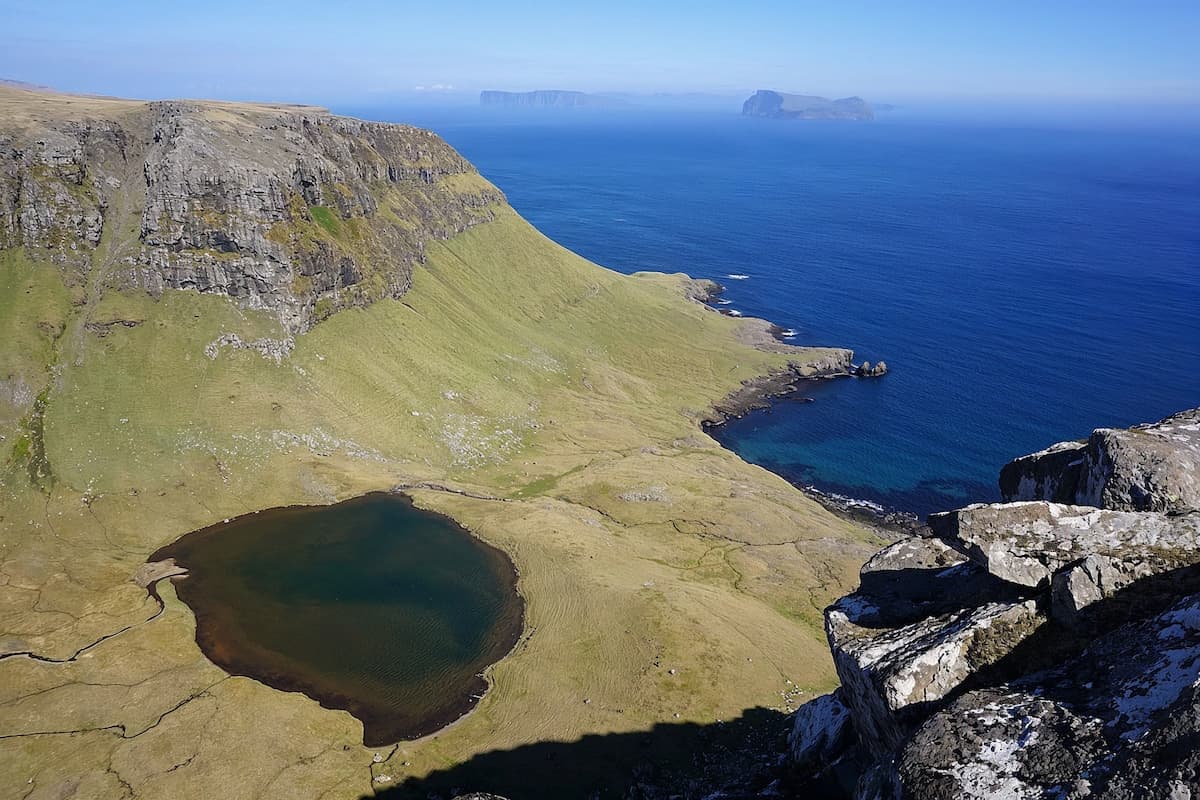
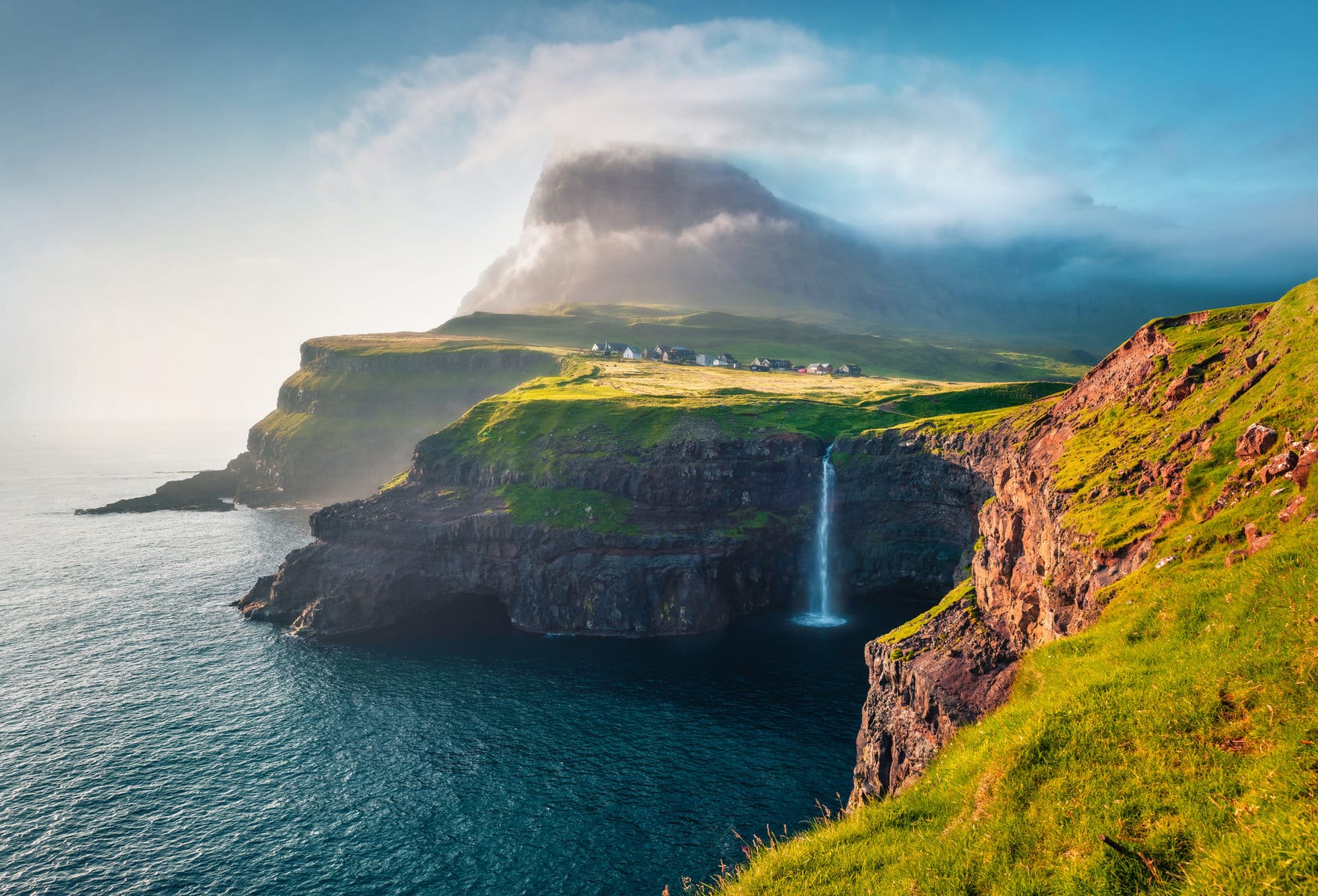
The Múlafossur Waterfall is not only a testament to the raw, untamed beauty of the Faroese nature but also a popular attraction for those who seek a tranquil escape.
| Quick Facts | |
|---|---|
| Location | Gásadalur, Faroe Islands |
| Accessibility | Short walk from Gásadalur |
| Best time to visit | Year-round |
| What to wear | Weather-appropriate clothing |
| Nearby attractions | Gásadalur village |
Your journey to the village of Gásadalur, home to the stunning Múlafossur Waterfall, will take you through breathtaking scenery.
Upon arrival, a brief walk will lead you to the prime viewpoint. Here, you will be greeted by the magnificent sight of water cascading into the Atlantic Ocean. The scene is enhanced by the vibrant green landscape and the unending harmony of the crashing waves.
Vágar Island is your gateway to Mulafossur Waterfall, with flights landing at Vágar Airport from various locations. When you arrive, you will see the beautiful scenery of the island, including Sørvágsvatn and the impressive Drangarnir sea stack.
The drive from Tórshavn takes about one hour by car. The village of Gásadalur is now easier to reach thanks to the Gásadalstunnilin Tunnel, which has made the village and the famous waterfall more accessible. The quick trip through the tunnel is just the beginning of the beautiful ocean views that lie ahead.
A parking area is provided at the edges of Gásadalur village. From there, your journey to Múlafossur comprises a gentle hike.
Clearly marked trails with signage and fences help ensure your safety while exploring Vágar’s beautiful landscape. They guide you directly to the best viewpoints to see the waterfall.
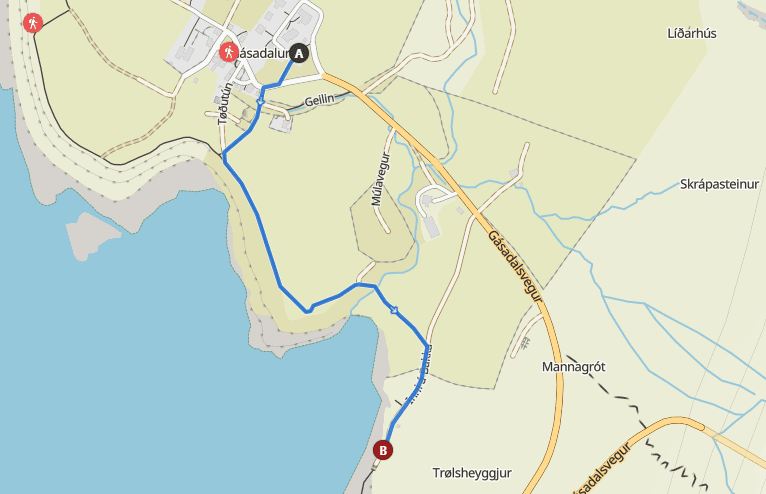
If you are in for a longer walk, you can take the old postman’s trail starting near the village of Bøur:
Visiting Múlafossur waterfall in Gásadalur will give you a memorable experience of Faroe Islands’ natural beauty, including panoramic views and cultural tales from the local environment.
The journey to Múlafossur allows for an unparalleled photographic opportunity. Stand at the designated viewpoint, and you’ll have the majestic waterfall with the backdrop of the North Atlantic Ocean.
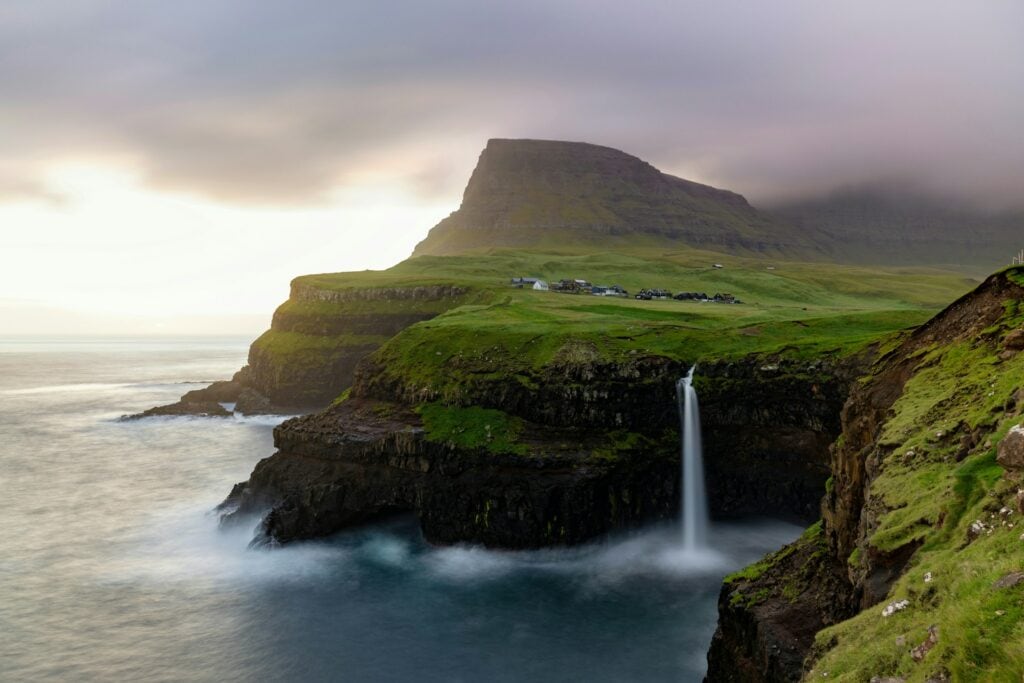
The contrasting scenes of the calm stream turning into a steep cascade as it plunges into the ocean is a visual treat. Be sure to wear sturdy boots, as the terrain around the waterfall can be slippery.
Weather plays a significant role in your visit. Conditions can be unpredictable; thus, checking the forecast is vital. Sudden changes can make the cliff paths dangerous, so it’s crucial to wear appropriate clothing and remain on marked trails for your safety.
In the rugged Faroe Islands, your experience with nature is unbridled and pure. The coastline, defined by the dramatic cliffs of Gásadalur, plays host to an array of wildlife, including the iconic puffins of Mykines Island.
Gásadalur, located on the west side of Vágar Island, is a region shaped by its isolation—safeguarded by mountains known as “Goose Valley.” Here, the environment thrives with diverse grasslands where sheep graze, maintaining the balance of the local ecosystem.
Mykines Island, a paradise for birdwatchers, is a significant habitat for seabirds. Your visit to the island might grant you the sight of puffins; these birds with their distinctive colourful beaks and whimsical appearance, nest prolifically among the cliffs. The island’s geography affords these species a safe haven from predators, while its coastline provides ample feeding grounds, ensuring a thriving avian population.
When you visit Múlafossur Waterfall, you have a variety of accommodation options and local amenities to enhance your stay in the serene village of Gásadalur and the wider region of Vágar.
In Gásadalur, you can indulge in the tranquillity of nature by choosing to stay in the cosy Múlafossur Cottages, conveniently situated with stunning views. Accommodations here are designed to give you a comfortable and intimate experience, allowing you to appreciate the village and its iconic waterfall at your leisure. Other options are the Gásadalur Apartments and pension Gásadalsgarður.
Vágar offers a blend of dining options and activities. Should you crave a meal, Sørvágur is merely a short drive away and hosts a selection of restaurants that cater to various tastes. Being the nearest significant town with an airport, Sørvágur makes for a convenient dining stop before or after your flights. The region also provides a bevy of activities for the adventurous spirit, from hiking the breathtaking landscapes to boat tours that allow you to absorb the grandeur of the Faroe Islands from the water.
If you’re planning a visit to Múlafossur Waterfall, equip yourself with the practical information that will ensure a safe and environmentally conscious trip.
Múlafossur Waterfall is accessible via a single-lane road leading through a beautiful valley to the village of Gásadalur. You’ll find clear paths leading to an established lookout point that offers a spectacular view of the waterfall as it plummets into the Atlantic Ocean. The terrain is managed with fences and markings to guide your way. However, the area can get windy, and paths may be uneven, so wear sturdy footwear.
The region around Múlafossur Waterfall is undergoing efforts to preserve its natural beauty and delicate ecosystem. When you visit, you play a part in these efforts. Please stay on marked paths, respect local fences and no-go areas, and do not leave any litter. By following these guidelines, you help maintain the health of the environment and the integrity of the waterfalls.
Responsible tourism ensures that the waterfall and its surroundings remain a pristine location for all to enjoy. Your adherence to these practicalities safeguards the site’s future.
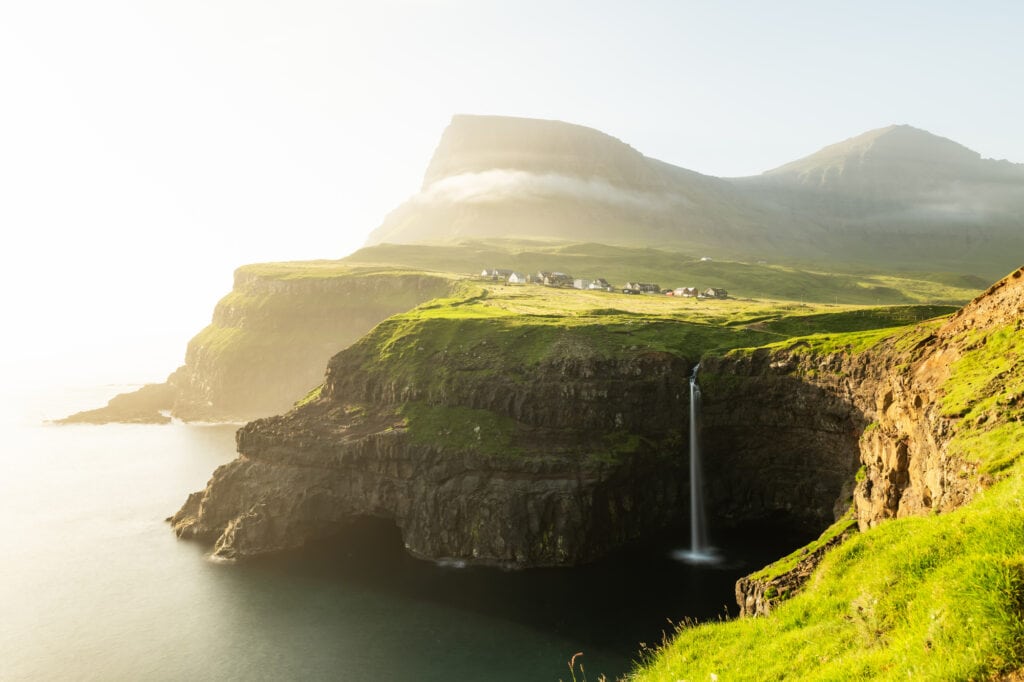
In uncovering the layered past of Múlafossur Waterfall, you’ll uncover tales woven into the fabric of the Faroese culture and the landscape of Gásadalur Village.
The Múlafossur Waterfall, with its majestic plunge into the North Atlantic, is not only stunning but also a bearer of legend. You may hear of mystical beings that the Faroese folklore believes to inhabit the area surrounding this remarkable cascade. The waterfall’s origin goes deep into the volcanic activity that shaped the Faroe Islands, and over time, it has been the centrepiece in tales told by generations of the villagers.
Gásadalur, the village that is home to Múlafossur, provides a window into the traditional Faroese way of life. Accessible by a path that was the only route for the postman to traverse, delivering mail to the isolated residents, it symbolises the determined spirit of the local people. The village’s cemetery speaks volumes of the community’s relationship with their land and their belief in eternal rest amidst nature’s quiet. Life here coexists with the elements, and the rugged terrain is marked by the grazing sheep, an integral part of Faroese agriculture and culture.
When planning your trip, consider both the season and how you wish to experience the natural wonder, whether through an organised tour or by yourself. Opting for a guided tour can enhance your visit with expert insights about the waterfall’s geology and surrounding flora.
The optimum time for your visit largely depends on the kind of experience you’re seeking. Summer offers extended daylight hours and milder weather, making it ideal for hiking and catching sight of the waterfall bathed in the midnight sun. On the other hand, the winter season presents the waterfall in a dramatic, frozen state, often accompanied by the northern lights. Keep an eye on the weather forecast as conditions can change rapidly.
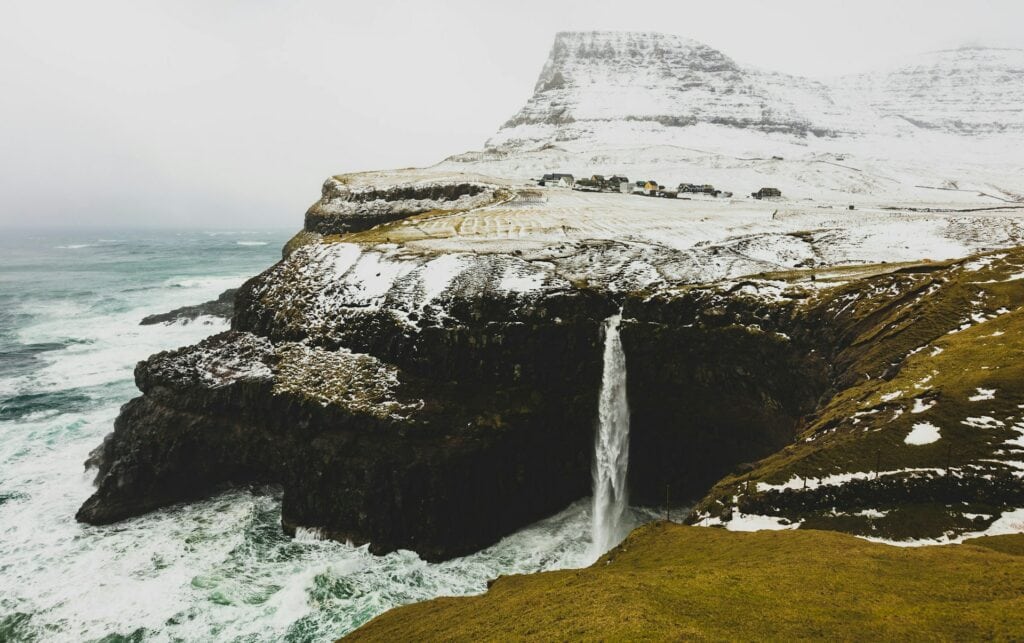
And daytime:
After marvelling at the waterfall, take the opportunity to explore nearby attractions such as the historical village of Bøur, with its traditional Faroese houses, and the awe-inspiring sea stack of Drangarnir, which frames the ocean horizon and can be appreciated from various trails and viewpoints around Vágar Island.
Visiting Múlafossur Waterfall offers a stunning view of the Faroe Islands’ raw beauty:
To immortalise the many moods of the Faroes’ most picturesque waterfall, you must be prepared for variable weather conditions. Whether shrouded in mist or glistening in sunlight, each state of Múlafossur offers a unique aesthetic appeal. It is no wonder that this location has become a sought-after subject not only for photographers but also for those involved in the visual arts.
Learn more about the Múlafossur Waterfall with these FAQs.
Múlafossur is a waterfall fed by a small river with a descent of 600 meters. It drops over 60 meters in a single fall into the Atlantic Ocean (1).
Swimming at Múlafossur Waterfall is not recommended due to the strong currents and cold temperatures of the North Atlantic waters that surround it.
Yes, there is a well-maintained path that takes you to a viewpoint for Múlafossur Waterfall, offering a safe and scenic route to experience this natural wonder.
Parking facilities are available in the village of Gásadalur, which provides convenient access to the waterfall for visitors.
Múlafossur Waterfall is the iconic cascade on the Faroe Islands that descends directly into the ocean, offering a truly unique and breathtaking sight.
While Múlafossur Waterfall is celebrated for its seaside location, the Fossá Waterfall is the tallest in the Faroe Islands and is known for its twin cascades and lush surrounding scenery.